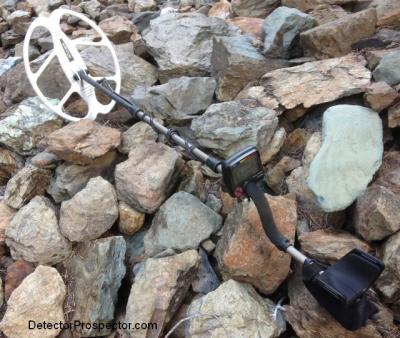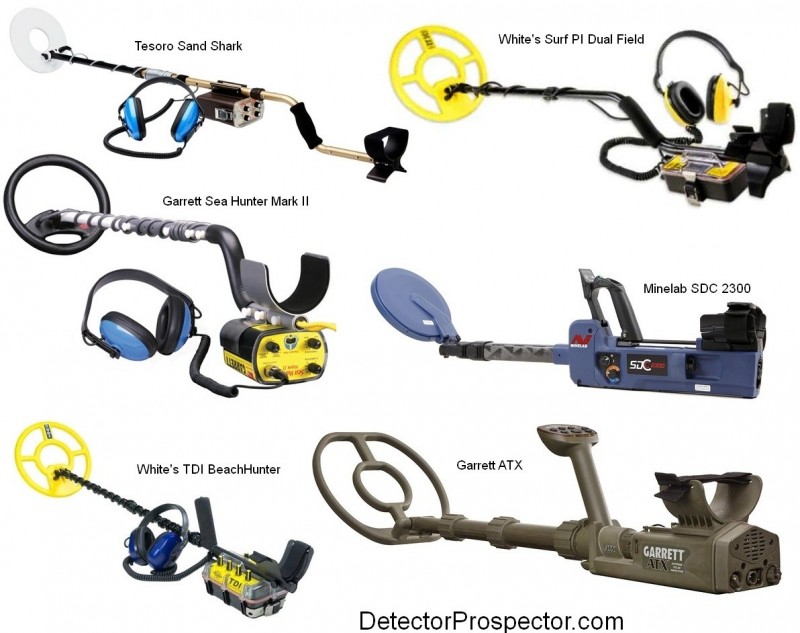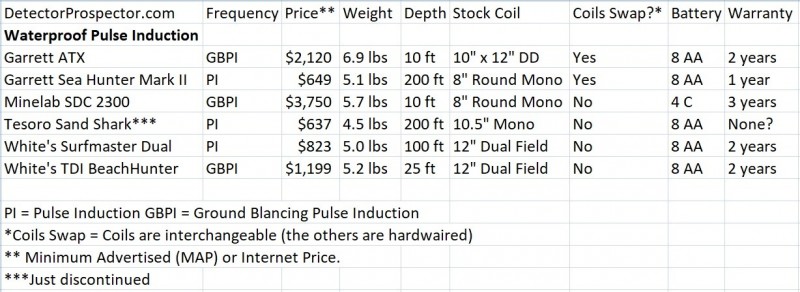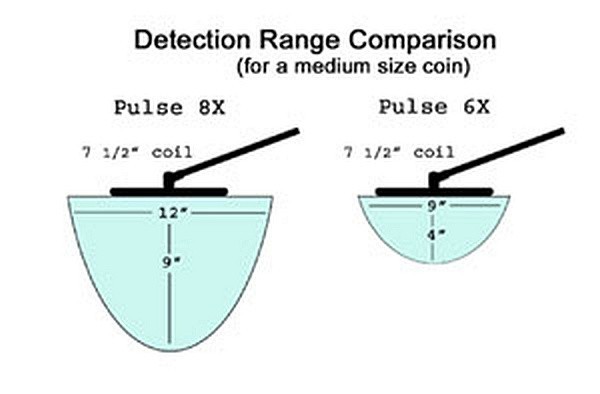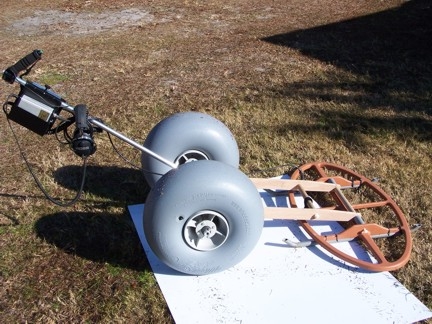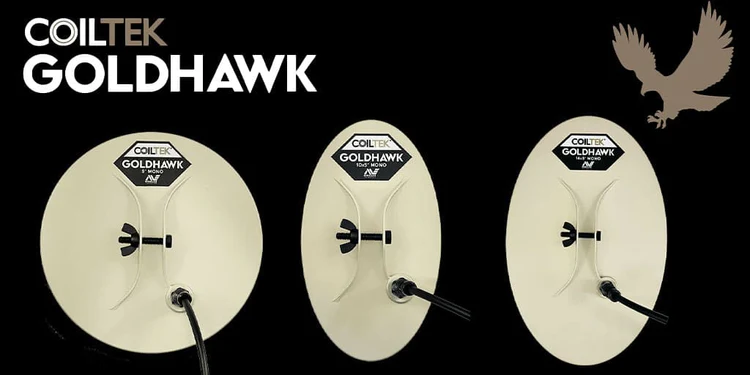-
Posts
19,736 -
Joined
-
Days Won
1,565
Content Type
Forums
Detector Prospector Home
Detector Database
Downloads
Everything posted by Steve Herschbach
-

What Can The Impulse AQ Do?
Steve Herschbach replied to EL NINO77's topic in First Texas - Bounty Hunter, Fisher & Teknetics
The AQ is completely useless in the goldfields, almost stunningly so given how well it works at the beach. I thought it might work in the fairly moderate salt ground in the northern Nevada gold locations, and found it banged relentlessly on hot rocks. It has no actual adjustable ground balance, the GB being preset as a crude discrimination system instead. The only way I could make it work was in black sand mode with long pulse delay and low sensitivity, which basically neutered it on gold nuggets. Long story short I'd rather use any decent VLF as being better, and any nugget PI made, even the Infinium and TDI, blow away the AQ for gold nugget hunting. The hoped for Impulse Gold to this day remains a dream unrealized that may or may not ever see the light of day. It appears Fisher simply abandoned the AQ series entirely to move on to a newer digital model, one that hopefully takes the various failures of the AQ into account. But even that has been in the works for years so who knows when and if it will be a reality....... -

Can Anyone Help Me Process My Ore?
Steve Herschbach replied to TheKID's topic in Detector Prospector Forum
You already have started two threads in other locations on this subject, so please do not start any more. I went ahead and combined the other two into the one below. Thanks. -

Help On Ore Processing
Steve Herschbach replied to TheKID's topic in Rocks, Minerals, Gems & Geology
If you are getting that much gold then it seems it would be worth your while to keep at it. In any quantity you'd be making a fortune. However, I can't imagine anyone on these forums being interested based on the photos you are showing, so no point in starting any new threads about it. jasongs answer was about the best I think you will get here but if you wait maybe somebody will respond more positively. -

Is It Just My Impression? Coil Impact
Steve Herschbach replied to raziel900's topic in XP Deus II Forum
Nobody on these forums has to preface anything with IMO because everything posted is only somebodies opinion. If anyone thinks they are just stating facts - well, no. All you are doing is stating your opinion of what you think the facts are. I agree with Chase. I state my experience, the other guy states their experience, somebody else states their experience - the reader can decide for themselves what is what. So, long story short, my style of posting is to state things as if they are facts. They are in my experience, but maybe not others. With metal detectors in particular everything depends on the ground and the targets, multiplied by operator experience. What is true for beach hunters in Florida is 100% not true for me nugget detecting in the Sierras. Different places and totally different ideas about what works and does not. The point is to take it all in and learn, not insist any one viewpoint is the "correct" one. Learn to see the big picture. -

Is The 8" Garrett Atx Mono Coil Worth It?
Steve Herschbach replied to Lead Detector's topic in Garrett Metal Detectors
The ATX just like the Gold Monster has bump sensitivity under some conditions and settings, and in my opinion expecting it to have none is expecting too much. Like Gold Monster users, you either learn to work around it or get a different detector. -
I define positive ground balance as the detector producing a slight sound when the coil goes to the ground. I define negative ground balance as the threshold going away, being suppressed, as the coil goes to the ground. There are almost no cases where a negative ground balance is going to help. In fact it can suppress the faintest signals if they occur while the coil motion is even slightly downward or ground rising under the coil. I always did a ground grab with any FT 19kHz machine, then manually bumped the balance one notch positive. This can easily be tested with any tiny target in the soil. A slight positive balance will preload the audio and often help the signal. Negative balance, just the opposite. I have heard about machines that people claim do better with a negative ground balance, but I suspect perception is more at work than verifiable proof. In the end it's not really an ask the question sort of thing. It's go find a target in your ground (when you can) and test it both ways and see what works better for you. But me, I never, ever ground balance negative, but do very often go just a touch positive.
-
Main database file was corrupt. I repaired it and should work again now, but this has been happening more frequently as of late and has me concerned about data loss. Hopefully the next forum update fixes it. If we get to a version that seems stable I may stop updating the forum software as most of the so-called updates do nothing to make our lives here any better, and always run the risk of breaking something. Anyway, add to this thread if anything else seems wrong still after I make this post. Thanks.
-

Need A New Pi For Beach Detecting
Steve Herschbach replied to Hard Prospector's topic in Metal Detector Advice & Comparisons
Guilty as charged. And I’ll admit I find your statement even more absurd. But I’m just an ignorant old schooler so what would I know. I’m pretty sure neither schoolofhardNox nor I need anyone’s books shoved down our throats. I have tons of experience in ground with real targets where the best SMF machines fail on any and all targets after a few inches. Try to show evidence though, and either the evidence or the knowledge level of the person doing the showing is attacked as inconsequential or ignorant. This whole nickel thing is a red herring. Even whether the particular videos involved have issues or not do not matter. Nickel, ring, brass casing, silver dollar, it does not matter. In extreme ground any VLF including a SMF falls on its face. Just because people have not experienced it they think it’s not true and won’t listen to people who know better. It’s impossible to educate people who already know everything and so in my case at least I’m content to just get on about doing what I do, as I quite literally have better things to do and will not participate in discussion nor respond to messages from this point forward. I’ll stick with basic admin work here that is needed to keep the forum going, like the table crash that occurred last night. Other than that, thank you all for putting up with me all these years, and best wishes to everyone in the coming New Year and beyond. Steve Herschbach, signing off. -

Need A New Pi For Beach Detecting
Steve Herschbach replied to Hard Prospector's topic in Metal Detector Advice & Comparisons
Why do VLF guys have to drop in on every PI thread to declare it’s not what they would use? Don’t. Nobody is telling you that you should. You obviously have never been in a place where your VLF gets 50% depth and calls anything past that as ferrous. If SMF was so great every gold prospector would be swinging one but fact is they are lackluster second cousins for performance compared to a good PI. The OP was asking for advice on a PI, not about anyone’s opinion on whether a PI is worth using or not. -
I had the pleasure of watching many people from all over the world detect for gold at Ganes Creek, Alaska and my own operation at Moore Creek. The difference between knowledgeable operators and the rest was astounding. 10% of the hunters got 90% of the gold and I am not exaggerating. A great detector means absolutely nothing if the operator does not have a good ear and good technique. The number one problem? Horrible coil control. Too high or too fast or both. The other biggie? An inability to hear faint targets, indicated by a pouch full of big stuff and no small stuff. Faint signals don’t mean just small targets, they mean 3 ounce nuggets two feet down. I do think some of this was simply an older crowd and poor hearing. And a large portion inattention bred by boredom. Boredom also contributed to the poor coil control. How else do you account for somebody waving a coil a foot off the ground? Nothing says I don’t want to dig another nail more than that! Which summed up means I can tell a good nugget hunter by just watching them a short while. A good operator is focused, coil under control. You can see how intent they are, and most likely they actually enjoy running a detector, even if no gold is being found. They like what they are doing. Other people find detecting boring, but make themselves do it, because they want to find gold. Chances are they will never be good at it. It’s that ability to keep your head in the game for hours on end that sets the good operators apart from everyone else, and skills honed with constant detecting. Going out a week or two once a year? That was what killed most of the visitors I saw. Some even were breaking a brand new detector out of the box for the first time on arrival for their long planned very expensive once in a lifetime trip. That is like playing a violin for the first time in front of a thousand people and not bothering to practice beforehand - good luck! Honestly, some people just suck at detecting and no detector can make up for that. If they do find gold it’s just pure blind luck.
- 38 replies
-
The proven reality in the field is actually simple. Detectors in the GPX 4000 - GPX 5000 class hammered ground for 20 years and going back to that ground with the same machines gets little or nothing. People going back over that ground with the GPZ 7000 and GPX 6000 are cleaning up what the older GPX series missed. A 4500/4800/5000 can help with hot rocks that bother the 7000 and 6000, but the problem there is it is eliminating those hot rocks that caused them to miss the gold in the first place. There is no free lunch. For every hot rock there is a class of gold target, as gold grades imperceptibly into the ground signal. Simply ground balancing a detector causes gold to be missed, and there is gold being missed to this day. But Minelab has been filling those detection “holes” as well as they can be filled for a long time now, and the gains to be had are minimal at best with whatever they come up with next. So yeah, you can save money buying a 4500, but are you really saving money, if it leaves you with crumbs while your mates fill their pockets with gold? In general you can treat a large number of detectorists as a pretty good indicator of what works and what does not. People tend to hold onto the old tech for a bit, but once it is shown something new puts more gold in pockets, a tipping point is reached and a shift occurs. Everyone, and I mean everyone I know, is using a 6000 or a 7000 or both. And it’s because it’s the better value proposition that results in more money, not less, compared to running older models. More upfront cost, but more gold found puts the good hunters ahead in the game. The nature of the gold to be found determines what detectors are best for the application. There are many locations where there simply are no large nuggets. So let’s draw an arbitrary line. 1 gram. And two classes of detector. When considering a GPZ 7000 or GPX 6000, if the area you hunt has a good possibility of larger gold at depth, say 1/4 oz and larger, then lean GPZ 7000. But if it’s all under a gram, the 6000 may actually do better. Leaving X-Coils out of the equation, the 6000 will hoover up small gold a 7000 misses. Step down to the GPX 5000 / Axiom class. If you have the possibility of larger deeper gold, then a 5000 outfitted with an 18” mono will have the edge. If the gold is predominately small, the Axiom will have the edge with similar size small coils versus the 5000. Another way to look at it is if I was chasing a six ounce nugget at max depth I’d probably look at the 5000 with big coil or the 7000. If I’m cleaning up smaller gold in well pounded areas, I’d be looking more at 6000 or Axiom. None of this is black or white, just shades of gray and generalities.
- 38 replies
-

How Well Does The Equinox 15" Coil Perform?
Steve Herschbach replied to TampaBayBrad's topic in Minelab Equinox Forum
Or the 900 is defective, not properly sensing the coil. -

Making Waterproof Smf Dive Capable
Steve Herschbach replied to mn90403's topic in Metal Detector Advice & Comparisons
Deus 2 good to 20 meters (65 feet) no modifications needed. Excalibur good to 200 feet out of the box. It's not that you have to use them to those depths. It means they are far more reliable to ten feet than detectors rated for a max of ten feet. IP68 only means up to 1.5 meters for more than 30 minutes, yet people quote IP68 like it means something is super waterproof. No, it is a bare minimum rating. -

Gold Kruzer And Gk40 Coil?
Steve Herschbach replied to Lead Detector's topic in Metal Detector Advice & Comparisons
Makro Gold Racer with GR40 15.5" x 13" coil I can’t speak to the Gold Kruzer but I liked the coil on the Gold Racer. Downside is it would be even more nose heavy on the Kruzer than it was on the Racer, even though it is a light coil for its size. Surprisingly sensitive to small items. It would add depth on larger items in low mineral ground but possible lose depth in high mineral ground, not uncommon on oversize VLF coils in extreme ground (that’s why PI exists). No matter what you will benefit from more ground coverage, but depth will be 100% dependent on how bad the ground is, and again, in the worst ground it could work against you. You can read my comments on the coil here in the last half of the review. -

Need A New Pi For Beach Detecting
Steve Herschbach replied to Hard Prospector's topic in Metal Detector Advice & Comparisons
This thread raises an interesting point. Here is a chart I made in 2019 showing available waterproof PI options: Fully submersible pulse induction metal detectors Bounty Hunter - no PI Garrett - Sea Hunter Mark II (PI) and ATX (GBPI) Fisher - no PI (one on the way?) Minelab - SDC 2300 (GBPI) Nokta/Makro - no PI Teknetics - no PI Tesoro - Sand Shark (PI) White's - Surfmaster Dual Field (PI) and TDI BeachHunter (GBPI) XP - No PI Finally, here are the key specifications for comparison: Fully submersible pulse induction metal detectors What a change just five years later! Tesoro and White's are no longer in business, reducing the number of models available new with full warranty by a full 50%!! We have a new option in the form of the Fisher Impulse AQ Ltd but I think that is less a new model for sale at this point than a failed experiment, with Fisher still trying to clear out the last of the limited 100 unit production run literally years after they started selling them. Less than 100 sold in four years is a bomb of epic proportions. In my opinion any AQ Ltd unit purchased new has a high chance of failure due to design flaws, and woe to the owners once they are out of warranty and the supply of spare parts runs out. Then we have the Minelab SDC 2300, which in my opinion is not a truly submersible waterproof detector in anything like the way most people imagine. It is based on a military design spec that required the unit to stand up to being submersed, but more in the form of a model to be floated across a lake or river. It floats like a cork and the tall flat sided body seems designed for maximum resistance when used underwater. I for one would not want to test the waterproof integrity of this $3500 detector by subjecting it to extended use in heavy surf. The SDC is not really a dive detector. So where does that leave us as far as waterproof PI detectors, brand new with warranty, going into 2024? Two models from one company! The Garrett ATX and Garrett Sea Hunter Mark II. The ATX is good to ten feet, and the Sea Hunter Mark II is a true SCUBA model good to 200 feet. There are lots of detectors good to ten feet, but I'll be frank in saying it is a stretch to call them fully waterproof. The IP68 rating only calls for a limited time underwater, not unlimited hours of submersion, and I only really consider models with 100 ft plus ratings to be the real deal. So I suppose I would be remiss in not mentioning a brand that almost never gets mentioned on this forum. J.W. Fisher, not relation to the Fisher brand we are all familiar with. This company specializes in underwater detecting technology including towable devices. They do make some handheld underwater models, like their Pulse 8X model. The 8X is as old school as you can get, a basic PI circuit in a bulletproof box that has been in production for decades. Not unlike the Garrett Sea Hunter in that regard. I used to be a dealer for them, and while it is solid reliable gear I can't really recommend the 8X due to the $2400 price tag. It is marketed to police departments and government agencies who are immune to the price for what is a very basic circuit with moderate performance at best. Anyway, it kind of amazes me how the options have become so limited. There is always the option to buy used, but anyone who has used underwater detectors for long knows that they almost always eventually leak if used a lot, and service out of warranty is not cheap. If service can even be had, a real concern for models like the Tesoro in particular. Shopping used means careful shopping for low hour models - avoid anything that looks like it has really been through the wringer, as it may be a great price when you buy it but cost a lot more later. Personally I always sold my underwater detectors right before the warranty ran out so my units were always under warranty. It is cheap insurance as far as I am concerned, for detectors with a far higher failure rate than normal dry land models, just due to the way they are being used. -
My only familiarity with large deepseeking PI are machines like the Minelab PI series with large coils. They are about as good as it gets for fist size and smaller targets, especially in mineralized ground, and certainly do well on even larger targets. That is why they are used worldwide for objects in that size class. There are other PI options with oversize coils like the Pulse Star for hunting targets that are larger than fist size, but part of wisdom is knowing what I don’t know, and I’ve not personally used those devices and so will decline to comment much on them. My main advice is scams and fantastic claims abound in the industry, and were it me, I’d stick with whatever the most popular devices are in widespread use, and avoid anything obscure. I have used the Gemini 3 back in my surveying days and it could easily locate water mains and large pipes at great depths, but that is the limit of my experience there. Devices like it and the TM-808 are at least reliable and affordable, and in low mineral ground would be my option. High mineral ground however calls for PI, so be patient and keep researching. More answers will probably appear here after the holidays. Geotech is an excellent source of trusted information. Minelab GPX 5000 with 3 foot coil mounted on push cart:
-

Which Coils For Which Situations
Steve Herschbach replied to oldmancoyote1's topic in Detector Prospector Forum
Use a mono when you can, and a DD when you have to (due to hot rocks and mineralization). Keep in mind that what matters as far as depth is the size of the receive coil. With a mono that is roughly the size of the coil itself. With a DD it’s maybe 60% of the coil area or less. So a if a mono coil and a DD coil are the same size physically, electronically the DD is the smaller coil. The DD handles the ground not only by separating the transmit and receive coils, which are the same winding in a mono, but by also “seeing” less ground. The DD is less prance to EMI for the same reason - smaller receive coil. Which goes back to use a mono if the ground/hot rocks and EMI allows, as you are getting more bang for the weight. DD coils were more popular prior to the GPX series, but the GPX was designed to take advantage of the inherent pluses in running a mono coil, and mono coils dominated from the GPX 4000 and after. But for the worst of worst ground a DD still has it’s place. -

Big News From Coiltek For Nox And Xterra Pro Users
Steve Herschbach replied to GR Guy's topic in Minelab Metal Detectors
Congratulations Trev on the company going to the next level. Over the years it was a tough call as to which company was doing the best job supporting Minelab users with aftermarket coils, but I'd say the answer is quite clear at this point - Coiltek. Good on you, and best wishes for a prosperous 2024. https://focusspeed.com/metal-detector-aftermarket-coil-leader-coiltek/- 50 replies
-
- coiltek
- minelab equinox
-
(and 1 more)
Tagged with:
-
https://en.wikipedia.org/wiki/Term_of_patent_in_the_United_States#:~:text=Under United States patent law,claimed (excluding provisional applications). “Under United States patent law, the term of patent, provided that maintenance fees are paid on time, is 20 years from the filing date of the earliest U.S. or international (PCT) application to which priority is claimed (excluding provisional applications).”
-

Building My Own Coil!
Steve Herschbach replied to SwampFox's topic in Metal Detector Advice & Comparisons
Your best source of information and help will be the Geotech Forums Coil Basics (PDF-506K) - This article describes a variety of induction-balanced coil methods. Coil Parameters - Database of coil parameters Coil Winder - How to make a device that will wind coils from 3 inches to 24 inches in diameter. Construction of Coplanar Search Coils - An easy method of making coplanar-concentric search coils. About Search Coils by Dave Johnson Search Coil Field Shape by Dave Johnson -

Home Made Metal Detectors
Steve Herschbach replied to Prince Zhakata's topic in Detector Prospector Forum
It seems like you are asking for help or offering to help at the same time? Gold nugget detecting is highly competitive and most people I know are using top end commercial detectors. Almost nobody here uses a homemade detector. If making metal detectors is your interest, you will find more information at the Geotech Forums

